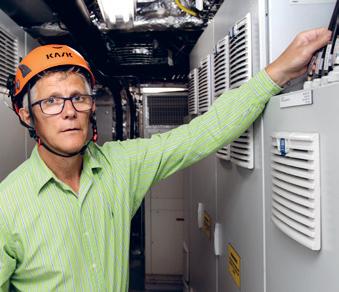
3 minute read
A beautiful ship – but
Skagerak at last in port
After years of problems and delays, the research vessel, Skagerak, has finally arrived in Gothenburg. The ultramodern ship has a super sounder that can map the ocean bed, a folding mast for atmospheric research, four laboratories and, not least, an extensive quarterdeck.
Advertisement
But the propulsion system is not working. Hopefully, this will soon be rectified so that Skagerak can be operational in May next year.
– STATE OF THE ART, says oceanographer Sebastiaan Swart when he presents Skagerak during the Faculty of Science’s press conference on June 10. – You can simply not find a better ship for oceanic research. Skagerak is incredibly well equipped but also prepared for additional equipment should it be required. I, for one, am hoping to be able to use our exciting underwater drones, the so-called ocean gliders, that have the capacity to be at sea for as long as 6-12 months. And it would also be interesting to bring the faculty’s new autonomous underwater vehicle (AUV) on board. But what I am most interested in doing initially, is to investigate the Swedish coastline, which has not been studied for decades.
THE SHIP IS 49 metres long, 11 metres wide and can house six crew members and 16 researchers or students. Project manager, Mats Hjortberg shows us the cabins, the kitchen and the engine room. The ship has two navigator seats, six winches and both a dry and a wet lab, he explains – Skagerak is fitted with four engines that generate power for the main engine. Not all engines need to run at the same time, you can run one or two of them when required, which saves energy and reduces wear and tear.
One important piece of equipment on the ship is the multibeam echo sounder mounted under the hull, says marine biologist Thomas Dahlgren.
Project manager Mats Hjortberg shows us the ship.

MATS HJORTBERG
– The sounder can be used to measure the deepest parts of the continental shelf, but also to map coastal areas. Personally, I am curious about the Norwegian Trench, which is located beyond the Koster Fiord and is around 750 metres deep. But I would also like to have a closer look at the world’s largest migration. That is the one which happens when fish and plankton migrate from the surface in the morning, where they have been feeding throughout the night, down to a depth of 500 metres on the open sea – but less than that in the Koster Fiord, for example. In general, the oceans are poorly explored, we actually know more about the surface of the moon or Mars.
Research and education on most aspects of marine chemistry, marine biology, marine geology, oceanography and atmospheric research will be possible on the ship, says Katarina Abrahamsson, Professor of Analytical and Marine Chemistry, who is responsible for the ship’s scientific equipment.
– THE MAST, for example, is foldable and contains pipes that lead directly down to a laboratory below deck that is specially equipped for atmospheric research. But although research is important, Skagerak is also a teaching vessel. And we have invested a lot in communication equipment so that lecturers at the university will be able to have direct contact with research groups here, for example.
It has not yet been decided which shipyard will complete the ship, but the procurement process is underway. – However, it has been decided that the Polish company MPL will replace and install a new propulsion system, says Mats Hjortberg. It is extremely complex work and will take several months. But when that and a few more details have been completed, the University of Gothenburg will have a very fine vessel, you couldn’t get much better.
Text: Eva Lundgren Photo: Johan Wingborg
Facts
Facts about Skagerak: 49 metres long, 11 metres wide, weighs 1,000 tonnes, maximum speed just over 12 knots, has space for 6 crew members and 16 researchers/ students. Construction period: Commissioned 2013, should have been delivered in 2015, the new delivery date is May 2021. Cost: Approximately SEK 200 million.

Skagerak is expected to be operational in May 2021. The system, where the four diesel engines give power to the main engine, has not been made to work.
– Welcome to my office, says oceanographer Sebastiaan Swart.











